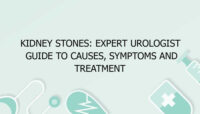Gallstones are hardened deposits of bile, a digestive fluid produced by the liver, that form in the gallbladder—a small organ located beneath the liver. These stones can vary in size, from tiny grains to large stones that can block the ducts leading to the liver or intestines. Gallstones are a common condition, and while they may not cause symptoms in many people, they can lead to serious complications if left untreated. Understanding the causes, symptoms, and treatments of gallstones can help individuals manage their condition effectively and seek timely medical intervention.
Causes of Gallstones
Gallstones are generally categorized into two types: cholesterol gallstones and pigment gallstones. Both types have different causes, but the underlying reason for gallstone formation usually involves an imbalance in the substances that make up bile.
Cholesterol Gallstones
Cholesterol gallstones are the most common type, making up around 80% of all cases. These stones form when there is too much cholesterol in the bile, which leads to the formation of crystals that eventually harden into stones. High cholesterol levels, along with other risk factors, can increase the likelihood of developing these gallstones. Key contributors to the formation of cholesterol gallstones include:
- Obesity: People who are overweight or obese are at higher risk because their bodies tend to produce more cholesterol.
- Unhealthy Diet: Diets high in saturated fats and low in fiber can contribute to the development of cholesterol gallstones.
- Pregnancy: Pregnant women experience changes in hormone levels that can increase the likelihood of cholesterol stones.
- Diabetes: People with diabetes tend to have higher cholesterol levels, making them more prone to gallstones.
- Liver Disease: Certain liver conditions can affect bile production, leading to an increased risk of gallstones.
Pigment Gallstones
Pigment gallstones are smaller and darker than cholesterol stones and are typically caused by excess bilirubin, a waste product from the breakdown of red blood cells. Conditions that increase the breakdown of red blood cells, leading to higher bilirubin levels, can result in pigment gallstones. The primary causes of pigment gallstones include:
- Hemolytic Anemia: This condition, in which red blood cells are destroyed prematurely, leads to increased bilirubin levels and can result in pigment gallstones.
- Liver Cirrhosis: In cirrhosis, the liver’s ability to process bilirubin is impaired, leading to higher levels of bilirubin in the bile.
- Biliary Tract Infections: Chronic infections of the bile ducts can lead to the formation of pigment stones.
Symptoms of Gallstones
Not everyone with gallstones will experience symptoms. However, when symptoms do occur, they are often related to blockages in the bile ducts, which can cause bile to back up into the liver or gallbladder. The resulting symptoms may include:
- Pain: The most common symptom of gallstones is pain, often referred to as a gallbladder attack. This pain usually occurs in the upper right abdomen or the center of the abdomen and can last for several hours. It may also radiate to the back or right shoulder.
- Nausea and Vomiting: Pain associated with gallstones can often be accompanied by nausea and vomiting, especially after eating a fatty meal.
- Indigestion and Bloating: Some people with gallstones experience chronic indigestion, feeling full or bloated after eating.
- Jaundice: If a gallstone blocks the bile duct, it can cause jaundice, a condition where the skin and eyes turn yellow. This happens because bile cannot flow properly, leading to a buildup of bilirubin in the bloodstream.
- Fever and Chills: In cases where a gallstone causes a biliary tract infection, the individual may experience a fever and chills, indicating an infection.
- Changes in Stool and Urine: Blockages caused by gallstones may lead to pale stools and dark urine due to the altered bile flow.
Treatment Options for Gallstones
Treatment for gallstones depends on the severity of the condition, the presence of symptoms, and the type of gallstones. In many cases, gallstones may not require immediate treatment if they are asymptomatic. However, when symptoms appear, several treatment options are available.
Non-Surgical Treatments
- Medications: In cases where surgery is not an option, doctors may prescribe medications to dissolve the gallstones. These medications are typically used for cholesterol-based stones and can take months or even years to be effective.
- Extracorporeal Shock Wave Lithotripsy (ESWL): This non-invasive treatment uses high-energy shock waves to break up gallstones into smaller pieces, which can then pass more easily through the bile ducts. This treatment is most effective for smaller cholesterol stones.
- Lifestyle Modifications: For individuals who are at risk of developing gallstones, certain lifestyle changes can help reduce the likelihood of formation. A healthy diet low in fat and high in fiber, regular exercise, and maintaining a healthy weight are all important preventative measures.
Surgical Treatment
The most common and definitive treatment for gallstones is cholecystectomy, a surgical procedure in which the gallbladder is removed. There are two main types of cholecystectomy:
- Laparoscopic Cholecystectomy: This is a minimally invasive procedure in which small incisions are made in the abdomen. A small camera and surgical instruments are inserted to remove the gallbladder. This method results in a shorter recovery time, less pain, and fewer complications.
- Open Cholecystectomy: In some cases, especially if there are complications such as large stones or infections, an open surgery may be necessary. This procedure involves a larger incision to remove the gallbladder.
Both types of surgery are generally safe, but as with any surgery, there are risks involved, including infection, bleeding, or injury to nearby organs.
Post-Surgery Care
After gallbladder removal, patients may experience some changes in their digestion, especially when consuming high-fat foods. However, most individuals can live without a gallbladder, as the liver continues to produce bile, which flows directly into the small intestine. It’s important to follow a low-fat diet initially and gradually reintroduce normal foods as tolerated.
Cost of Gallstone Treatment
The cost of gallstone treatment can vary greatly depending on the type of procedure, the country, and the healthcare facility. In India, the cost of laparoscopic cholecystectomy ranges from ₹50,000 to ₹1,50,000 (approximately $600 to $2,000), including surgery, hospitalization, and post-operative care. Open cholecystectomy tends to be more expensive and may cost between ₹80,000 and ₹2,00,000 ($1,000 to $2,500). Non-surgical treatments, such as medications, can cost between ₹5,000 to ₹15,000 ($70 to $200), depending on the type of medication and duration of treatment.
In the United States, the cost of gallstone surgery is significantly higher. A laparoscopic cholecystectomy can cost between $10,000 to $20,000, depending on the hospital and location, while an open cholecystectomy may cost upwards of $25,000. Non-surgical treatments can range from $500 to $4,000, depending on the medication and procedure involved.
Gallstones Causes, Symptoms, and Treatment Table
| Causes | Symptoms | Treatment |
|---|---|---|
| Cholesterol imbalance: High cholesterol levels, obesity, and unhealthy diets increase the risk of cholesterol gallstones. | Pain: Typically in the upper right abdomen, radiating to the back or shoulder. | Laparoscopic Cholecystectomy: The most common and effective treatment to remove the gallbladder. |
| Hemolytic Anemia: Increased destruction of red blood cells leads to higher bilirubin levels, which can result in pigment gallstones. | Nausea and Vomiting: Pain often causes nausea, especially after fatty meals. | Medications: Oral bile acid medications to dissolve cholesterol stones, though this is a slower process. |
| Pregnancy: Hormonal changes can affect bile composition, increasing the risk of gallstone formation. | Indigestion and Bloating: Common after eating high-fat meals. | Shock Wave Lithotripsy: A non-invasive treatment that breaks stones into smaller pieces. |
| Liver Cirrhosis: Impaired liver function increases bilirubin levels, contributing to pigment gallstones. | Jaundice: Yellowing of the skin and eyes, caused by bile duct blockage. | Open Cholecystectomy: In some cases, open surgery is necessary, especially for complicated gallstone cases. |
Frequently Asked Questions
What are the main causes of gallstones?
Gallstones primarily develop when there is an imbalance in the components of bile, specifically cholesterol or bilirubin. The two main types of gallstones are cholesterol gallstones and pigment gallstones. Cholesterol gallstones are often caused by high levels of cholesterol in the bile, which may occur due to factors like obesity, poor diet, or liver disease. On the other hand, pigment gallstones form when there is excess bilirubin in the bile, which can occur in conditions such as hemolytic anemia, liver cirrhosis, or chronic biliary tract infections. Other factors such as pregnancy, diabetes, and age can also increase the likelihood of developing gallstones.
How do I know if I have gallstones?
Many individuals with gallstones don’t experience any symptoms, a condition known as “silent” gallstones. However, when symptoms do occur, they are often related to blockages in the bile ducts. The most common symptom is pain, particularly in the upper right abdomen or center of the stomach. This is often referred to as a gallbladder attack. Other signs include nausea, vomiting, indigestion, and bloating, especially after eating fatty foods. Jaundice, a yellowing of the skin and eyes, can also occur if a gallstone blocks the bile duct. If you experience any of these symptoms, it is important to consult a doctor for diagnosis and treatment.
What is the treatment for gallstones?
The treatment for gallstones depends on whether they are causing symptoms or complications. If gallstones are asymptomatic, they may not require treatment. However, when symptoms such as pain, nausea, or blockages occur, the primary treatment is usually gallbladder removal surgery (cholecystectomy). Laparoscopic cholecystectomy is the most common method, as it is minimally invasive, requiring only small incisions. In some cases, medications can be used to dissolve cholesterol-based stones, but this is typically a slower option. Non-surgical treatments such as shock wave lithotripsy may be used for smaller stones. Your healthcare provider will recommend the most appropriate treatment based on the type and severity of your condition.
Can gallstones go away on their own?
While some small gallstones may not cause symptoms and remain dormant for long periods, they typically do not go away on their own. Cholesterol stones may be dissolved using medications, but this process is slow and may take months or years. Pigment stones, on the other hand, often require more definitive treatments such as surgery or lithotripsy. If you experience severe symptoms or complications, surgery may be necessary to remove the gallbladder and prevent further issues.
Is gallstone surgery risky?
Like any surgery, gallstone surgery (especially cholecystectomy) does carry some risks. However, laparoscopic cholecystectomy is a minimally invasive procedure with a low complication rate. Risks include infection, bleeding, or injury to nearby organs, such as the bile ducts. However, these complications are rare, and the vast majority of patients recover without significant issues. Patients are generally advised to follow post-operative instructions and attend follow-up appointments to ensure the best possible recovery.
How long does recovery take after gallstone surgery?
Recovery after laparoscopic cholecystectomy is typically quick. Most patients can return to normal activities within 1 to 2 weeks. Some mild discomfort or bloating may persist for a few days, but pain is generally manageable with over-the-counter medications. For more invasive procedures like open cholecystectomy, the recovery time is longer, typically 4 to 6 weeks. Regardless of the type of surgery, it’s important to follow your doctor’s instructions on diet and activity restrictions to promote a smooth recovery.
What is the diet after gallstone surgery?
After gallstone surgery, patients are often advised to follow a low-fat diet for several weeks, especially after the gallbladder is removed. The gallbladder stores bile, which helps in digesting fats, so without it, the body may have difficulty digesting fatty foods. A low-fat diet, rich in fiber and lean proteins, can help prevent digestive discomfort. Gradually, most patients can reintroduce normal foods, but it’s important to avoid heavy meals, fried foods, or fatty foods initially.
Can gallstones come back after surgery?
Once the gallbladder is removed, gallstones cannot form in the gallbladder because it is no longer present. However, some individuals may still experience bile duct stones, although this is rare. In most cases, gallbladder removal eliminates the risk of further gallstone formation, and patients can enjoy a normal, healthy life without further issues. Maintaining a healthy diet and lifestyle can help prevent other bile-related problems.
Are there any complications after gallbladder removal?
While complications after gallbladder removal are rare, they can occur. Some people experience diarrhea, indigestion, or bloating after surgery due to changes in bile flow. In some cases, bile duct injury or infection can occur, although these complications are uncommon with laparoscopic techniques. It’s important to follow post-operative care instructions and attend follow-up appointments to ensure proper healing and address any concerns promptly.
Is surgery the only treatment option for gallstones?
Surgery is the most common and definitive treatment for gallstones, especially for symptomatic cases. However, non-surgical options such as medications to dissolve cholesterol stones or shock wave lithotripsy may be considered in certain situations. Medications are less commonly used, as they can take a long time to work and may not be effective for all patients. If you are a candidate for surgery, it is typically the most effective and quickest way to alleviate symptoms and prevent future complications.


